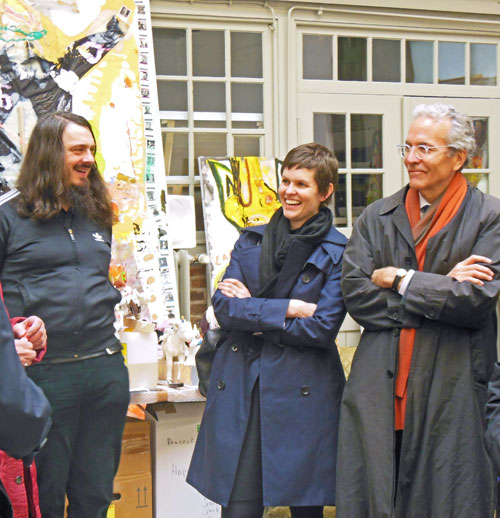Efficient. Humble. Curious. Driven. Considerate. A role model. These are just some of the ways Harvard Art Museums staff have described Thomas W. Lentz, the outgoing Elizabeth and John Moors Cabot Director. His last day on the job will be July 1. Humorous memories and thoughtful reflections make clear the deep impression he will leave after 12 years as director.
Lynette Roth, the Daimler-Benz Curator of the Busch-Reisinger Museum, recalled Lentz’s willingness to embrace contemporary positions and his commitment to strengthening collections in this area. During a tour of Berlin as part of the museums’ Fellows program, the group stopped at the studio of contemporary (and some might say, provocative) German artist Jonathan Meese, whose work is far different from the Islamic art that Lentz specializes in. Yet he was very open to the experience and to meeting the artist, Roth said. (The entertaining visit is captured in the above photo featuring Meese, Lentz, and Roth.) “Tom is not somebody who will go along just to be there,” Roth said. “He is always willing to engage.”
Narayan Khandekar, director of the Straus Center for Conservation and Technical Studies and senior conservation scientist, recounted a similar experience when traveling to Australia in 2013 with Lentz to conduct research for the upcoming Everywhen exhibition. The trip required long days of driving through the desert and investigating a realm of art—Aboriginal paintings—with which Lentz wasn’t very familiar. Still, “his intellectual engagement was palpable,” Khandekar said. “There was also something amazing about the director of the museums spending so much time on this project.”
Lentz’s natural curiosity has been an invaluable leadership trait. “He’s a master question-asker—like the Charlie Rose of museum directors,” said chief curator and interim co-director Debi Kao. “He asks quietly provocative questions and is fascinated by everything. As a result, he’s incredibly well-versed on a range of topics.” Added deputy director and interim co-director Maureen Donovan: “He never worries about asking a question, and in that way he leads by example.”
A number of other individuals also characterized Lentz as a mentor. “He completely trusts his staff and their expertise,” said Daron Manoogian, the museums’ director of communications. That makes him “a very unusual leader. I’ve never seen or experienced anybody who is so selfless and so completely appreciative of the work of others.”
While many describe Lentz as humble, they also see him as disarmingly hard working. When it came time to reinstall the galleries following the renovation and expansion of the museums, Lentz read every object label—and provided detailed feedback. Considering that curators wrote new labels for almost all works in the inaugural installation, this was no small feat. Miriam Stewart, curator of the collection for the Division of European and American Art, has known Lentz since he was a graduate student at Harvard. “I am always impressed by how well he knows the collections,” she said.
There are lighthearted memories, too. Kao and Donovan, both of whom have had occasion to travel with Lentz on museum business, remarked on his efficiency and minimalism—perhaps nowhere more evident than in his ability to pack a (modest) carry-on suitcase. “He brings what I’d call a magic Mary Poppins bag,” Kao said. “We were amazed that he could fit everything in there—shoes, shirts, suits,” Donovan added.
And this drive for minimalism extends to his desert-dry sense of humor. “He’s the king of the one-liner,” Kao said with a smile.
Of course, Lentz will forever be associated with the complete transformation of the Harvard Art Museums; and yet there are smaller, more personal ways he makes a difference each day. He has remained actively engaged with Harvard students, even during the busiest moments in the renovation project, serving as a freshman advisor over the years and setting aside time to offer a personalized tour of the new facility to the student guides last fall. And as several longtime museum attendants have attested, he always takes the time to say hello when passing through the galleries.
His presence will certainly be missed—in big and small ways. All of us here at the museums wish him the best of luck on the journey ahead.


